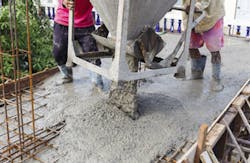What's the ideal mix of ingredients in cement? Research published in the journal Nature Communications suggests a new formula that could reduce greenhouse-gas emissions while also improving durability.
Concrete — a mixture of sand, gravel, water and cement — is the world's most-used construction material and its manufacture makes a significant contribution to global warming. Most emissions come from the production of cement, which is made by cooking calcium-rich material, usually limestone, with silica-rich material such as clay at temperatures of 1,500 degrees Celsius. That results in a hard mass called "clinker" which is then ground up into a powder.
A detailed molecular analysis of the complex structure of concrete has been made by Roland Pellenq, senior research scientist at MIT, together with professors Krystyn Van Vliet, Franz-Josef Ulm, Sidney Yip and Markus Buehler and eight co-authors at MIT and CNRS in Marseille, France. They discovered that reducing the ratio of calcium to silicate would not only cut harmful emissions, but would actually produce better, stronger concrete.
Conventional cements have a calcium-to-silica ratio from about 1.2 to 2.2, with 1.7 accepted as the standard. After building a database of all the chemical formulations, the researchers found that the optimum mixture was not the one typically used today, but a ratio of about 1.5.
At that point the material can achieve "two times the resistance of normal cement, in mechanical resistance to fracture, with some molecular-scale design," Pellenq explained.
This improved resistance to mechanical stress means that the revised formulation could be of particular interest to the oil and gas industry, where cement is used around well casings to prevent leakage and blowouts.
